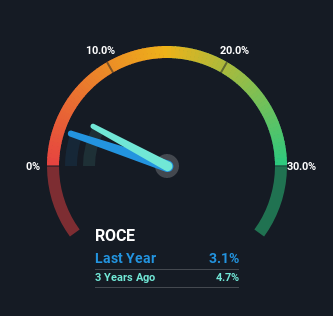Capital Allocation Trends At Singapore Airlines (SGX:C6L) Aren't Ideal

Finding a business that has the potential to grow substantially is not easy, but it is possible if we look at a few key financial metrics. Typically, we'll want to notice a trend of growing return on capital employed (ROCE) and alongside that, an expanding base of capital employed. This shows us that it's a compounding machine, able to continually reinvest its earnings back into the business and generate higher returns. Although, when we looked at Singapore Airlines (SGX:C6L), it didn't seem to tick all of these boxes.
What Is Return On Capital Employed (ROCE)?
For those that aren't sure what ROCE is, it measures the amount of pre-tax profits a company can generate from the capital employed in its business. To calculate this metric for Singapore Airlines, this is the formula:
Return on Capital Employed = Earnings Before Interest and Tax (EBIT) ÷ (Total Assets - Current Liabilities)
0.031 = S$1.2b ÷ (S$51b - S$11b) (Based on the trailing twelve months to September 2022).
Thus, Singapore Airlines has an ROCE of 3.1%. In absolute terms, that's a low return and it also under-performs the Airlines industry average of 8.4%.
See our latest analysis for Singapore Airlines

Above you can see how the current ROCE for Singapore Airlines compares to its prior returns on capital, but there's only so much you can tell from the past. If you'd like to see what analysts are forecasting going forward, you should check out our free report for Singapore Airlines.
The Trend Of ROCE
On the surface, the trend of ROCE at Singapore Airlines doesn't inspire confidence. Over the last five years, returns on capital have decreased to 3.1% from 5.3% five years ago. Although, given both revenue and the amount of assets employed in the business have increased, it could suggest the company is investing in growth, and the extra capital has led to a short-term reduction in ROCE. And if the increased capital generates additional returns, the business, and thus shareholders, will benefit in the long run.
Our Take On Singapore Airlines' ROCE
Even though returns on capital have fallen in the short term, we find it promising that revenue and capital employed have both increased for Singapore Airlines. However, despite the promising trends, the stock has fallen 18% over the last five years, so there might be an opportunity here for astute investors. As a result, we'd recommend researching this stock further to uncover what other fundamentals of the business can show us.
One final note, you should learn about the 2 warning signs we've spotted with Singapore Airlines (including 1 which shouldn't be ignored) .
While Singapore Airlines isn't earning the highest return, check out this free list of companies that are earning high returns on equity with solid balance sheets.
New: Manage All Your Stock Portfolios in One Place
We've created the ultimate portfolio companion for stock investors, and it's free.
• Connect an unlimited number of Portfolios and see your total in one currency
• Be alerted to new Warning Signs or Risks via email or mobile
• Track the Fair Value of your stocks
Have feedback on this article? Concerned about the content? Get in touch with us directly. Alternatively, email editorial-team (at) simplywallst.com.
This article by Simply Wall St is general in nature. We provide commentary based on historical data and analyst forecasts only using an unbiased methodology and our articles are not intended to be financial advice. It does not constitute a recommendation to buy or sell any stock, and does not take account of your objectives, or your financial situation. We aim to bring you long-term focused analysis driven by fundamental data. Note that our analysis may not factor in the latest price-sensitive company announcements or qualitative material. Simply Wall St has no position in any stocks mentioned.
About SGX:C6L
Singapore Airlines
Together with subsidiaries, provides passenger and cargo air transportation services under the Singapore Airlines and Scoot brands in East Asia, the Americas, Europe, Southwest Pacific, West Asia, and Africa.
Undervalued established dividend payer.
Similar Companies
Market Insights
Community Narratives




